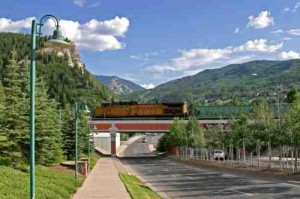Column by George Sibley
Labor – October 2006 – Colorado Central Magazine
LABOR DAY will be long gone by the time you are reading this, dear reader, but it’s when I’m trying to write it. “Plan ahead” isn’t in my nature, so I seldom manage to think a month ahead to what’s going to be in the news when this column actually hits the press.
But anyway — here on Labor Day, I’m trying to figure out what we should do about laboring in this world. Or maybe I am trying to figure out what we should do about this world’s laboring. For it does seem, if the news is to be believed, that the world is in fact laboring these days to keep up with us. Overheating, running a temperature, and flipping out to extremes — horrible hurricane season one year, nothing the next year; big snows in the southern mountains one year and nothing in the northern mountains, then it reverses. And we keep cranking the CO2 and methane and whatall into the world’s lungs and the world’s breathing grows more laborious.
But that’s just the world laboring. What about laboring in the world? Government statistics that came out just a week or so before Labor Day were not positive. If you are actually laboring at some job in this world, then you are a) doing a better job at stressing the world (which is to say, worker productivity is up), but b) getting less return on your effort (worker incomes continue to drop relative to costs of things).
“What jumps out at you is the gaping hole between productivity growth and earnings,” said Jared Bernstein, an economist at the Economic Policy Institute in Washington. People are “working harder and smarter but not really seeing remuneration that they ought to be seeing.” Good workers are, in other words, basically paying out to stress the world.
If, on the other hand, you are sitting in an air-conditioned apartment or mutual-fund office where progress is measured by the Dow and NASDAQ standards, then you are doing fine, or at least your employer is doing better all the time.
There’s the further fact that if you are not employed at hard labor but need to be, the picture is not very rosy either. There are lots of jobs, allegedly, but most of them are lousy jobs, and a lot of the once-well-paying industrial jobs are now being done by “affordable” laborers from or in Mexico and points east, west and south. Economist Dean Baker, co-director of the Center for Economic and Policy Research in Washington, points out that “U.S. manufacturing workers now have to compete with workers in Mexico, China and other developing countries, who often earn less than $1 a day, [which] puts downward pressure on the wages of large segments of the workforce” (for those who needed the obvious stated).
But Baker goes on to muse that “globalization did not have to take this form. It’s true that the developing world has a vast supply of potential labor for manufacturing. But it is also true that the developing world has a vast supply of very bright individuals who could be trained to work as doctors, lawyers, accountants, and economists….
“Suppose,” Baker continued, “our trade agreements over the last quarter century had been designed to facilitate free trade among highly paid professionals. Specifically, these agreements would be about setting clear and transparent education and training standards that would allow bright kids in Mexico, China, and elsewhere to study to become doctors, lawyers, accountants, and economists in the United States…. If globalization had gone this route, the economy would have experienced enormous economic gains over the last quarter century. Lower doctors’ salaries would save consumers tens of billions of dollars each year on their health care costs. Lower salaries for university faculty would bring down the cost of a college education. And, lower lawyers’ fees would bring down legal costs that get embedded in the price of all goods and services.”
BUT THINGS DIDN’T GO THAT WAY, so from the labor perspective, where rising costs for professional services are just another burden on top of diminishing wages for jobs with increased productivity pressures, there’s not much — wasn’t much — to celebrate this Labor Day, so I’m glad I’m not mucking up the holiday for anyone with this late report.
The most interesting news I’ve encountered about work and labor recently was in a guest editorial in the New York Times on Labor Day — a fellow academic and writer named Tom Lutz, author of Doing Nothing: A History of Loafers, Loungers, Slackers and Bums in America), who has done some research in working back in the 19th century — a “pre-industrial world of agricultural and artisan labor [that] was structured by what the historian E. P. Thompson calls ‘alternate bouts of intense labor and of idleness wherever men were in control of their working lives.'”
“Agricultural work was seasonal,” Lutz notes, “interrupted by rain, forced into hyperactivity by the threat of rain, and determined by other uncontrollable natural processes. The force of long cultural habit ensured that the change from such discontinuous tasks to the regimented labor of the factory never went particularly smoothly…. American manufacturing laborers came and left for the day at different times. Monday, one manufacturer complained, was always ‘given up to debauchery,’ and on Saturdays, brewery wagons came right to the factory, encouraging workers to celebrate payday. Daily breaks for ‘dramming’ were common, with workers coming and going from the work place as they pleased. Their workdays were often, by 20th-century standards, riddled with breaks for meals, snacks, wine, brandy and reading the newspaper aloud to fellow workers.”
That might have been the way it was in the city with the craft workers, but it was not the working environment that the fathers of my old miner friends in Crested Butte found in Colorado; they had to literally put their lives on the line to get the work day down to only eight continuous hours with a day off a week. But it came to the same thing: laborers know that work should not be the most important thing in life. “Eight hours for work, eight hours to sleep, and eight hours for the rest of our lives” was the cry.
NOW, OF COURSE, those of us who are employed brag, in a groaning kind of way, about how hard we work, how many hours we put in, how busy busy busy we are. We have somehow made a kind of fetish of overwork; there’s something almost un-American about not being overworked, and maybe being underpaid also makes us more proud.
It makes me think with some fondness of my days when I inadvertently seemed to have a kind of balance there. I’ve been “over-worked white-collar” for the past two decades over here in the Upper Gunnison, but I do remember my earlier construction days in Crested Butte, working for Hickok Hickok and Hickok Construction — those days of the two-beer lunch, when Boss Hickok joined us, and we all ambled back to work to see if we could maintain intact fingers all afternoon, and keep from falling off the roof. It was stupid, sure, but so was the work we were doing — building 2,000 square-foot second homes that are now mostly being torn down to make way for 7,000 square-foot second homes where the work is entirely too upscale finicky to allow for even a one-beer lunch (although there’s a suspicious haze in the air around some of those jobs).
But now I look on those days with both longing and guilt — longing because, today, as one of the fortunate employed, I work my ass off and brag about it. But guilt because I realize I was enjoying the tag end of a Golden Age that the fathers and brothers of the old guys I drank beer with had laid their lives on the line to get — a work day down to a paid eight.
Are we making any headway here? Is anything getting better? I hope at least you didn’t have to celebrate Labor Day by fighting for time-and-a-half.
George Sibley writes from Gunnison, where he is organizing the annual Headwaters Conference scheduled Nov. 10-12.


